Kubernetes and Cloud Native Security Associate (KCSA)
Compliance and Security Frameworks
Automation and Tooling
In this lesson, we recap essential automation and tooling for cloud-native security. Throughout this course, you’ve explored multiple open source and commercial solutions. Here, we review those tools, highlight alternatives, and reference key resources such as the Cloud Native Security Whitepaper by SIG Security.
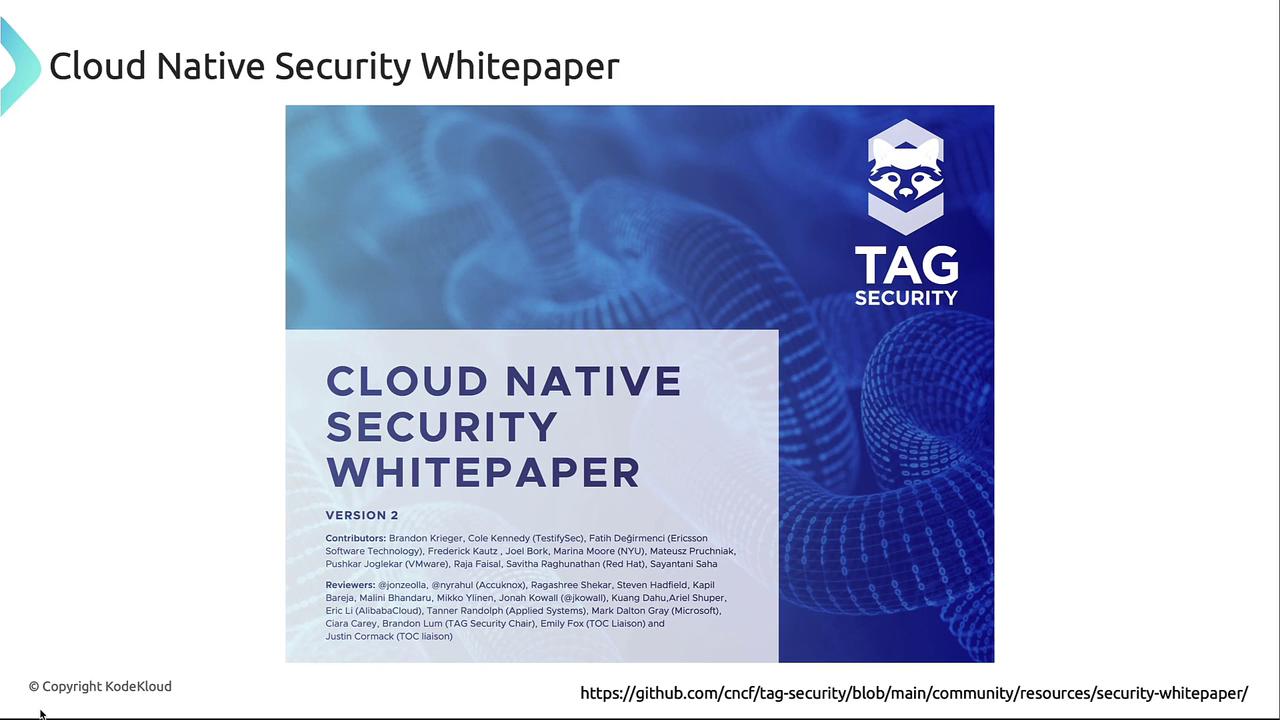
The Cloud Native Security Whitepaper provides foundational guidance authored by industry experts. To interactively explore security tools mapped to each phase of the application lifecycle, visit the Cloud Native Security Map:
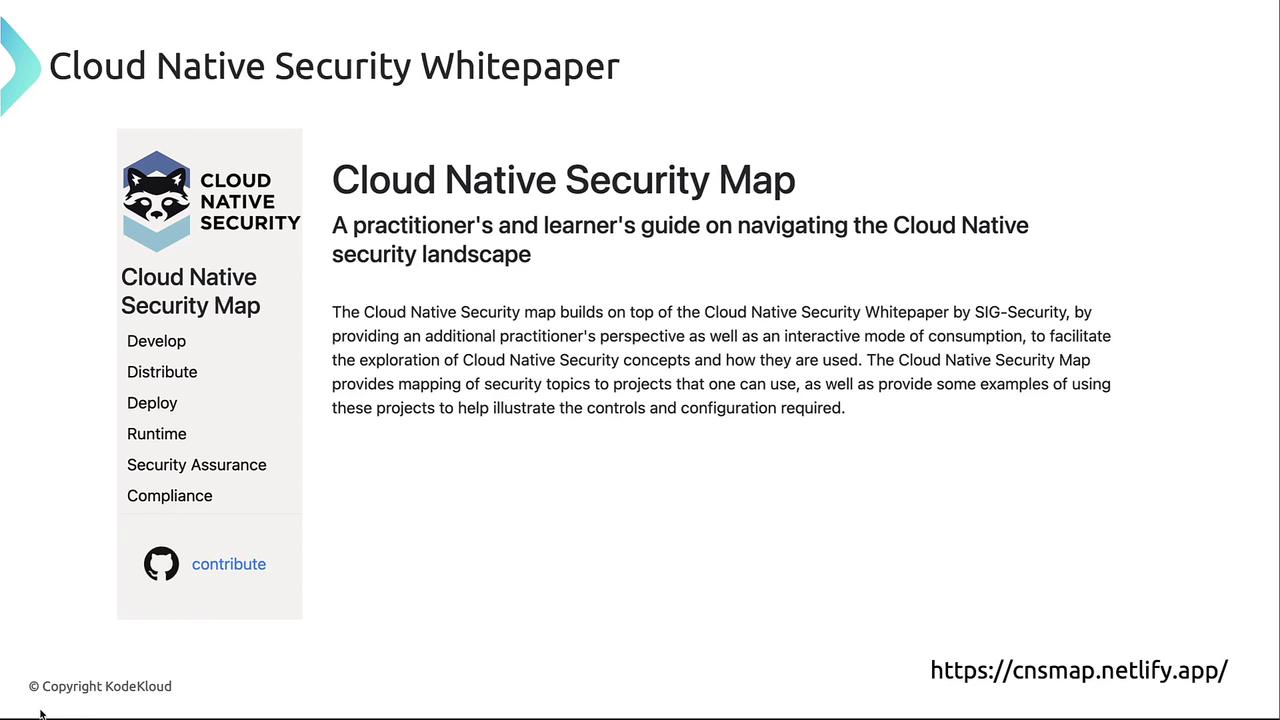
Note
Explore the interactive map at cnsmap.netfly.app to discover security tools and best practices organized by Develop, Distribute, Deploy, and Runtime phases.
Development Phase
The Develop phase emphasizes “shift-left” testing by integrating security early in code, Dockerfile, and infrastructure-as-code creation. Commit artifacts to repositories (GitHub, GitLab, etc.) with automated checks to:
- Block high-severity vulnerabilities when fixes exist
- Enforce non-root container execution
- Restrict allowed base images
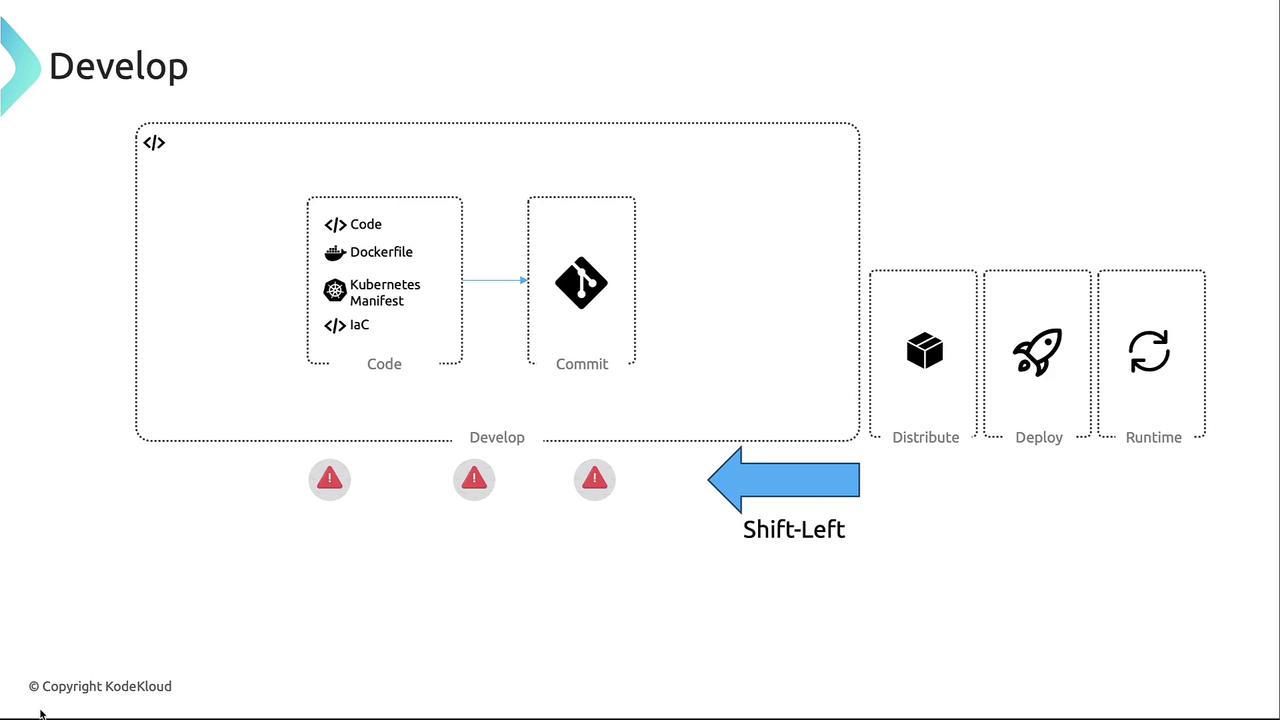
Fuzz Testing with OSS-Fuzz
Google’s [OSS-Fuzz][oss-fuzz] automates fuzz testing of open source projects to discover crashes and undefined behavior.
def parse_integer(input_string):
try:
return int(input_string)
except ValueError:
return "Error: Not a valid integer"
Below is a simple fuzz harness for parse_integer:
import random, string
def generate_random_string(length=10):
charset = string.ascii_letters + string.digits + string.punctuation
return ''.join(random.choice(charset) for _ in range(length))
def fuzz_test_parse_integer(iterations=10):
for _ in range(iterations):
rand_in = generate_random_string(random.randint(1, 20))
print(f"Testing: '{rand_in}' -> {parse_integer(rand_in)}")
fuzz_test_parse_integer()
Example output:
Testing: '@123$%' -> Error: Not a valid integer
Testing: '87ab1' -> Error: Not a valid integer
Testing: '' -> Error: Not a valid integer
Testing: '42' -> 42
IDE & CLI Security Extensions
- [Snyk VS Code Extension][snyk-vscode]
- Fabricate by Red Hat (VS Code plugin)
- [kube-linter][kube-linter] – Scan Kubernetes YAML:
kube-linter lint pod.yaml
Distribution Phase
In the Distribute phase, CI/CD pipelines build, test, and push container images to registries. Common tools include:
| CI/CD Pipeline Tool | Use Case |
|---|---|
| Tekton | Kubernetes-native pipelines |
| Jenkins | Extensible automation server |
| Travis CI | Cloud-hosted continuous testing |
| CircleCI | Container-based CI |
| Flux CD | GitOps continuous delivery |
| Argo CD | Declarative GitOps controller |
Before building images, enforce policy compliance on manifests:
- [KubeSec][kubesec] scans Kubernetes YAML for misconfigurations.
- TeraScan validates IaC (Terraform, Dockerfile, Helm, CloudFormation) against CIS, NIST, GDPR, HIPAA.
Violation Details =
Description: [Enabling S3 versioning allows easy recovery]
file: modules/s3/main.tf
Severity: 101
Rule ID: AWS.S3Bucket.IAM.High.0370
Warning
Always validate manifests before image builds to prevent deployment of insecure configurations.
After validation, build and scan images:
| Scanner | Scope | Example Command |
|---|---|---|
| Trivy | Container images, filesystems, Git repos | trivy image myapp:latest |
| Clair | Static image analysis via API | API integration |
| Grype | Images & filesystem scanning | grype myimage:tag |
| Nuclei | Custom checks via YAML templates | nuclei -t templates/ |
To secure the software supply chain, use signing frameworks:
- [in-toto][in-toto] – End-to-end supply chain security
- [Notary][notary], [TUF][tuf], [Sigstore][sigstore]
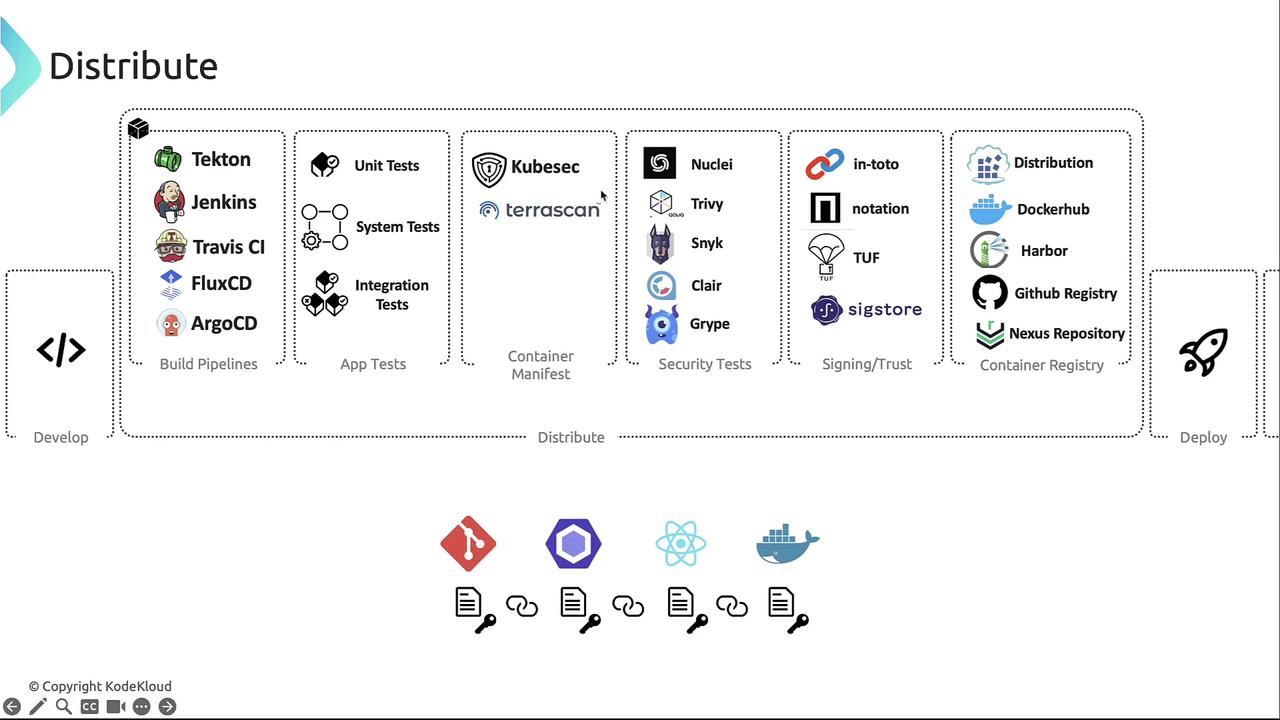
Deployment Phase
The Deploy phase covers pre-flight checks, observability, and incident response:
Pre-flight Checks
- [OPA Gatekeeper][gatekeeper] – Policies in Rego
- [Kyverno][kyverno] – YAML-based policy management
Observability
- [Prometheus][prometheus] + [Grafana][grafana]
- [Elasticsearch][elasticsearch] + [Kibana][kibana]
- [OpenTelemetry][otel]
Response & Investigation
- [Wazuh][wazuh]
- [Snort][snort]
- [Zeek][zeek]
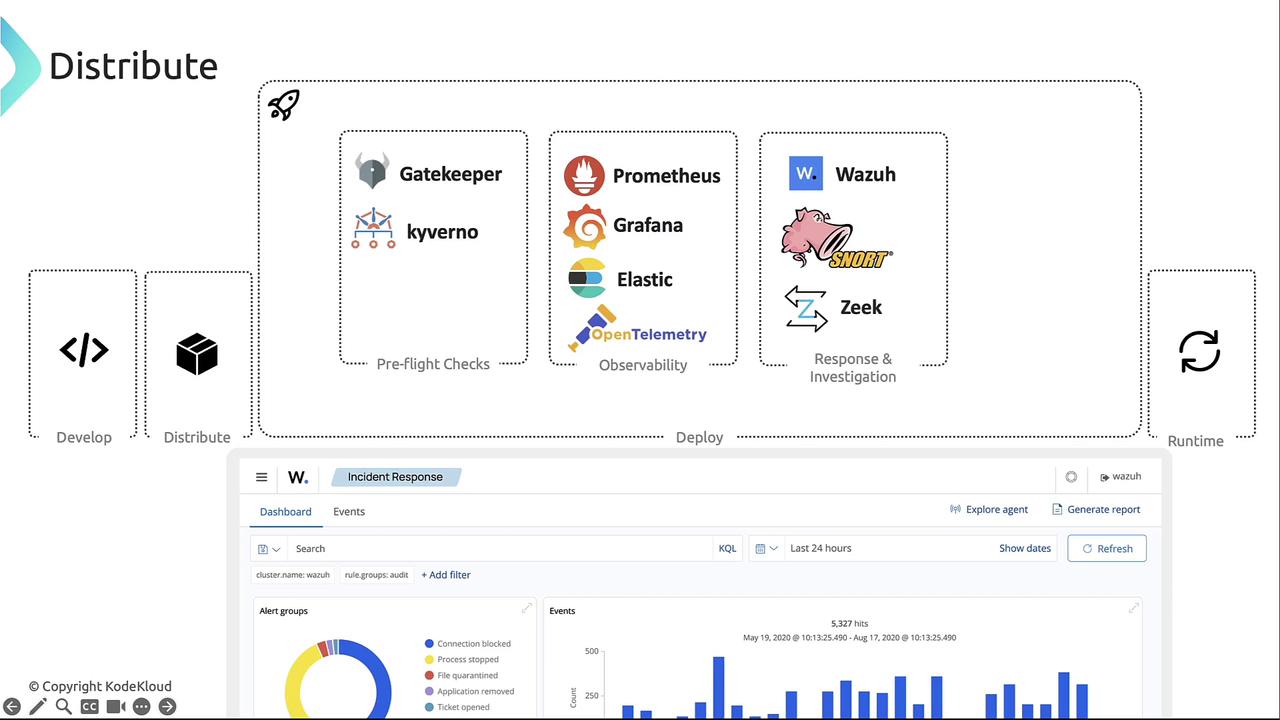
Runtime Phase
Once applications are live, enforce continuous security and reliability:
- CIS Benchmarking
- [kube-bench][kube-bench] – CIS checks for Kubernetes clusters:
[FAIL] 1.1.1 Ensure --allow-privileged is false
[PASS] 1.1.2 Ensure --anonymous-auth is not set
Runtime Security
- Falco – System call monitoring
- Trivy – Continuous workload scanning
- SPIFFE – Workload identity via certificates
Service Mesh
- Istio, Linkerd
Storage Orchestration
- Rook, Ceph, Gluster
Access Management
- Keycloak, Teleport, HashiCorp Vault
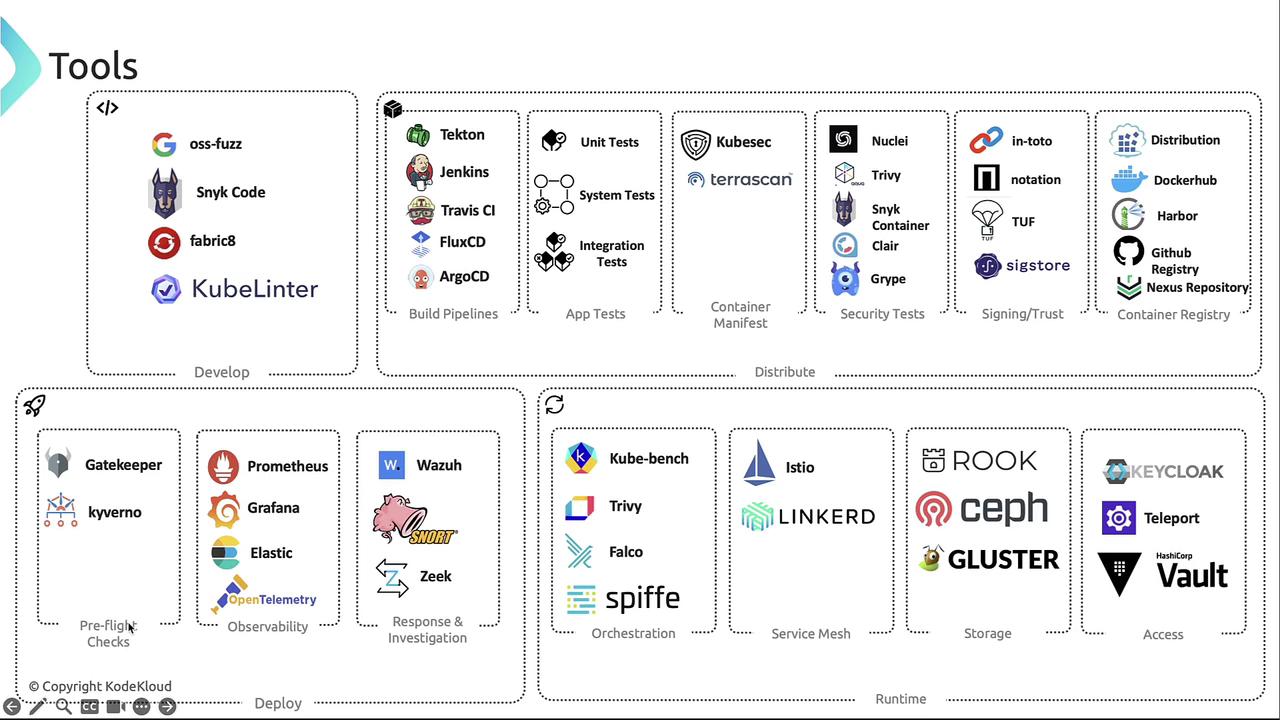
Summary
Map these tools to your cloud-native lifecycle for improved security and efficiency:
- Develop: Shift-left scanners & IDE plugins
- Distribute: CI/CD pipelines, manifest & image scanners, signing frameworks
- Deploy: Policy enforcement, observability, incident response
- Runtime: Continuous monitoring, service mesh, access & storage management
Links and References
- OSS-Fuzz: https://github.com/google/oss-fuzz
- Snyk VS Code Extension: https://marketplace.visualstudio.com/items?itemName=snyk-security.snyk-vulnerability-scanner
- kube-linter: https://github.com/stackrox/kube-linter
- KubeSec: https://github.com/controlplaneio/kubesec
- in-toto: https://github.com/in-toto/in-toto
- Notary: https://github.com/theupdateframework/notary
- The Update Framework (TUF): https://theupdateframework.io/
- Sigstore: https://sigstore.dev/
- OPA Gatekeeper: https://github.com/open-policy-agent/gatekeeper
- Kyverno: https://kyverno.io/
- Prometheus: https://prometheus.io/
- Grafana: https://grafana.com/
- Elasticsearch: https://www.elastic.co/elasticsearch
- Kibana: https://www.elastic.co/kibana
- OpenTelemetry: https://opentelemetry.io/
- Wazuh: https://wazuh.com/
- Snort: https://www.snort.org/
- Zeek: https://zeek.org/
- kube-bench: https://github.com/aquasecurity/kube-bench
- Tekton: https://tekton.dev/
- Jenkins: https://www.jenkins.io/
- Travis CI: https://travis-ci.org/
- CircleCI: https://circleci.com/
- Flux CD: https://fluxcd.io/
- Argo CD: https://argo-cd.readthedocs.io/
- Docker Hub: https://hub.docker.com/
- Harbor: https://goharbor.io/
- GitHub Container Registry: https://github.com/features/packages
- Nexus Repository: https://www.sonatype.com/product-nexus-repository
Watch Video
Watch video content